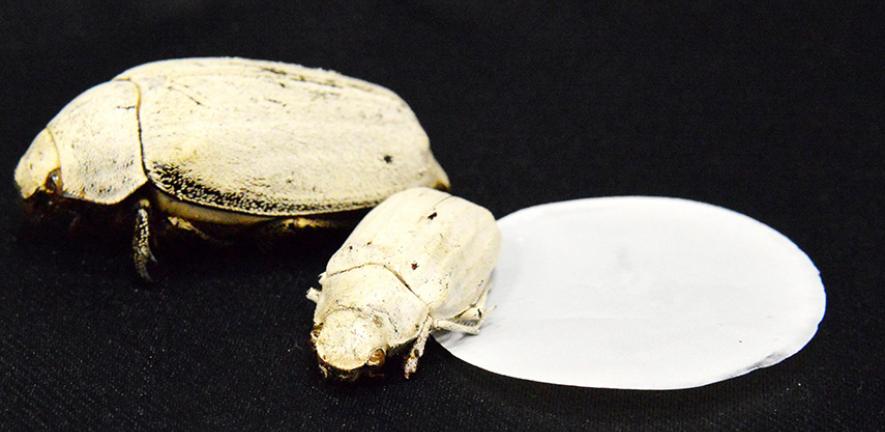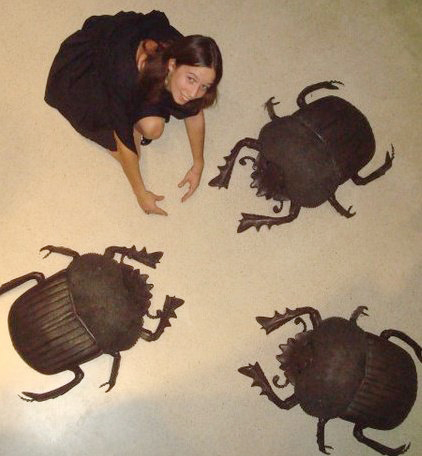
They researchers say it can help improve the appearance and performance of a range of products from cosmetics to paints.
"The Cyphochilus beetle’s scales are extremely thin – just one hundredth of the width of a human hair. If you cut a sheet of paper as thin as that, it would be transparent. But the beetle’s scales still appear very white." Olimpia Onelli.
Scientists in the Department of Chemistry have been studying the ‘super-white’ Cyphochilus beetle for several years. Intrigued by the exceptional light-scattering properties of its scales, which make the beetle appear to be white even though its body is black, PhD student Olimpia Onelli and her supervisor Dr Silvia Vignolini have been researching ways of creating a material that mimicked these properties.
And as they report today in the journal Advanced Materials, they have been successful. Inspired by the structures and properties of the insect’s scales, and using natural materials, they have successfully created a new material whose whiteness "far exceeds that of common paper". The new material also has the benefit of being ultra-thin.

Their work was helped by a collaboration with researchers at Aalto University in Finland.
Lead author Dr Vignolini, a Reader here in the department, says: "This work paves the way for developing a viable large-scale method for producing white coatings that are sustainable." She and co-author Olimpia Onelli have already patented the material and are now hoping to license it for manufacture in products such as cosmetics.
For the Cyphochilus beetle, its exceptional whiteness (in proportion to its size) is a survival mechanism that camouflages it among the white fungi found in its habitat. It has also been of great interest to scientists since it was first noted, by Prof Pete Vukusic at Exeter University, almost a decade ago.

The Chemistry researchers knew that the key to the beetle’s whiteness lies in the interaction of light with its scales. As Olimpia explains: "Our eyes see whiteness when they are exposed to light that contains all the colours in the visible spectrum. In nature, organisms like the beetle produce this effect by having many non-uniform regions of their body – we call them ‘scattering centres’ – that disperse the light randomly and reflect it back at us from a variety of directions. When all colours are scattered equally well, it appears white."
But they were intrigued by the fact that the beetle’s scales produce this effect despite being extremely thin. Usually materials require a certain degree of thickness (typically a few hundred microns) in order to have enough of these scattering centres to reflect the light and make it appear white. The beetle, however, is a fascinating exception to this rule.
"The Cyphochilus beetle’s scales are extremely thin – just one hundredth of the width of a human hair," says Olimpia. "If you cut a sheet of paper as thin as that, it would be transparent. But the beetle’s scales still appear very white."
To find out how the beetle achieves this effect, Silvia Vignolini and her co-authors used electron microscopy to study its scales. They knew, from Prof Vukusic’s discovery, that the scales contain many scattering centres, but this research revealed that the structure works so efficiently because these scattering centres are very densely packed in the scales without being overcrowded.
It has long been thought that manufacturing an ultra-thin synthetic material that could achieve the same degree of whiteness as this was an insurmountable challenge. But inspired by these findings, the researchers have now made extremely thin membranes that achieve a very bright whiteness despite being only a few microns thick.
This could be of interest to a wide range of consumer goods sectors. Manufacturers have been looking for new ways to enhance the whiteness of materials – from sun creams to toothpaste to paints – without using whitening agents that can affect consumers’ health or adversely impact the environment.
As they describe in Advanced Materials, the research teams created these ultra-thin membranes using nanoscale cellulose fibres found naturally in wood pulp. This porous membrane material was originally conceived for use as a chemical filter, but the Cambridge researchers studied the way light is carried in it and discovered that it appears extremely white.
They then found that by adjusting the size and architecture of the nanoscale fibres within it, they could tweak it to produce different levels of whiteness, from extremely white to transparent.
They achieved this by 'tuning' the porosity of their cellulose material, and adjusting its structure and the packing of the scattering centres within it. They found that when the material has few pores, it does not scatter light so well because its appearance is uniform; when this happens, the material looks transparent. But when a large number of pores are embedded in it, light 'sees' them as variations and is thus scattered, producing a white colouration.
The researchers say the resulting ultra-thin material has a whiteness that rivals that of materials that have much higher light-reflecting properties but cannot be manufactured in an environmentally sustainable way.
"And the research isn’t over yet," says Ms Olimpia. "We are hoping to do further research and to see if we can optimize this material even more."
-
The paper - "Anomalous-Diffusion-Assisted Brightness in White Cellulose Nanofibril Membranes" - is published in Advanced Materials today (Tuesday 13 March): http://onlinelibrary.wiley.com/doi/10.1002/adma.201704050/full
- The research was undertaken through a collaboration between Dr Silvia Vignolini and PhD students Olimpia Onelli and Gianni Jacucci in Cambridge, and Professor Olli Ikkala and PhD student Matti Toivonen in Aalto University Finland. The funding for the Cambridge arm of the research came from the European Research Council and a BBSRC David Phillips Fellowship.

